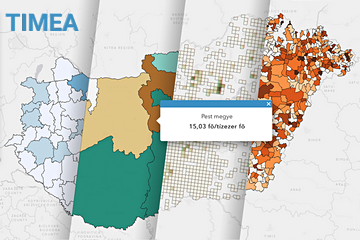Justice
Justice statistics covers data related to criminal investigation, litigation, operation of the judiciary system, justice, security, victims, clearance rates as well as number of inmates, minor offences, the judicial activity of courts.
Key figures
Number of registered crimes per hundred thousand inhabitants aged 14 years and over
Indicator description
The number of crimes per hundred thousand inhabitants aged 14 years and over for which the investigator authorities finished the investigation and provided data on them in the given period.
Source of data:
Summary Tables (STADAT)
Last data for period: 2024
Number of perpetration incidents per one hundred thousand inhabitants aged 14 years and over
Indicator description
Natural persons, for whom at least one crime has been registered throughout the year; the perpetrator will be registered as many times as the number of crimes committed by them.
Source of data:
Summary Tables (STADAT)
Last data for period: 2024
Number of detainees in penitentiary institutions
Indicator description
Number of detainees (persons under remand, convicted persons, persons sentenced to forced therapy, imprisonment, sent to prison temporarily) in penitentiary institutions on the last day of the year.
Source of data:
Summary Tables (STADAT)
Last data for period: 2024
Number of victimisation incidents per one hundred thousand inhabitants
Indicator description
The number of persons registered as victims of registered crimes as many times as the number of crimes is in the given case.
Source of data:
Summary Tables (STADAT)
Last data for period: 2024
Featured
Statistical Yearbook of Hungary, 2024
The yearbook provides an overview of Hungary's demographic, social and economic trends, environmental characteristics and their changes over time, with the help of tens of thousands of data in some 500 tables, charts and maps. In the chapter devoted to earnings and incomes, it is a novelty compared to previous years that net earnings in which allowances and types of exemptions are accounted for, too, came into focus from 2019. In the number of employees, people working in working time shorter than 60 working hours per month are also taken into account. In addition, the theme of environment is completed with areas declared world heritage sites by UNESCO.
Yearbooks, pocketbooks, data repositories
A new sub-page has been added to the HCSO website, more than 400 yearbooks, pocketbooks and data collections, a total of a hundred thousand pdf format pages close to 150 thousand excel tables and several thousand static and interactive graphs and maps are available for download. The sub-page offers the possibility of filtering these yearbooks, pocketbooks and data collections by reference year, serial name, format (PDF, XLS) and supplements (graphs, maps). Users may compile their own list of publications based on the year- and pocketbooks, data collections, adequate to their interests.
Statistical Pocketbook of Hungary, 2024
The tables and charts in the latest edition of the Statistical Pocketbook of Hungary provide a comprehensive insight into the development of social and economic trends in Hungary during the year 2024. It aims to provide a summary picture of the country's situation in all possible areas based on preliminary indicators. Within the number of employees, this year's pocketbook also includes employed persons working less than 60 hours, and the gross revenues at tourist accommodation establishments.
Courts’ Day, Hungary
The National Judiciary Council (NJC) declared 15 July the Courts’ Day in Hungary in 2000. Cases received by the Courts of Justice reached 1.2 million in 2023, within it 243 thousand litigations. The former was 2.3% higher, the latter was 1.8% over the one year earlier level. The number of preliminary decision cases brought to the Court of Justice of the European Union by the Courts of Hungary decreased compared to 2022.
Number of victimisation cases down
38.8 thousand crimes were registered in the second quarter of 2022, which is 5.7% more than a year earlier. The number of perpetrations increased (by 8.9%), but the number of victimisation decreased slightly (by 0.5%) compared to the same period last year. The number of crimes increased in the capital and 11 counties and decreased in 8 counties. The largest increase was in Borsod-Abaúj-Zemplén county (28%) and the largest decrease in Csongrád-Csanád county (31%).
Related themes
- Men and women
- Population and vital events
- Regional statistics
- Social care protection
- The young and the elderly
Methodological information
Release and revision calendarPublication repertory







